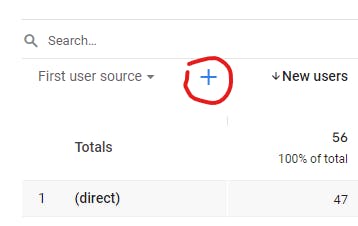Enhance Your Reporting with Secondary Dimension in Google Analytics
Enhance Your Data Analysis Utilizing Additional Measurement in Google Analytics
Exploring the abilities of additional dimensions in Google Analytics opens up a realm of possibilities for refining data evaluation. By layering extra dimensions onto primary information sets, an even more complex story arises, losing light on user communications and performance indications.
Comprehending Secondary Measurements
In the realm of information evaluation, an essential facet to grasp is the idea of additional dimensions and their relevance in drawing out much deeper insights from Google Analytics records. Second dimensions in Google Analytics describe additional criteria that can be included in the main dimension, permitting a much more thorough analysis of data. By incorporating additional dimensions, experts can segment and filter data to reveal patterns, trends, and relationships that might not be evident when looking at the data as a whole. These additional measurements can provide context and a much more thorough understanding of user habits, website traffic sources, and various other key metrics tracked by Google Analytics.

Benefits of Utilizing Second Measurements
When analyzing data in Google Analytics, the application of additional dimensions offers indispensable insights right into individual behavior and efficiency metrics. By including a secondary measurement to your key information, you can dig much deeper into the attributes of your web site visitors and their communications. Among the vital advantages of using second dimensions is the capability to section and contrast data extra successfully. This segmentation enables you to understand just how different variables, such as demographics or traffic sources, influence customer behavior and conversions (Secondary Dimension in Google Analytics).
In addition, secondary dimensions assist in recognizing patterns and correlations that may not be immediately evident when looking at the data alone. This deeper degree of evaluation can reveal valuable info that can direct advertising and marketing techniques, internet site optimization, and total business choices. Furthermore, second dimensions improve the context of your primary data, giving a more detailed view of user engagement and performance metrics. Generally, the use of additional dimensions in Google Analytics can dramatically improve the depth and quality of your data evaluation, leading to even more enlightened decision-making and boosted end results.
Just How to Include Additional Dimensions
By incorporating second dimensions in Google Analytics, users can get much deeper insights right into their information evaluation process, permitting for even more comprehensive examination of customer habits and efficiency metrics. Including additional measurements is an uncomplicated process that can considerably improve the deepness of evaluation. Once in the record, situate the "Additional measurement" tab over the data table.
Studying Data With Additional Dimensions
Utilizing secondary dimensions in data analysis offers a much more thorough understanding of customer habits and efficiency metrics. By adding an additional dimension to your key data embeded in Google Analytics, you can delve much deeper into the attributes of your web site site visitors and their interactions. As an example, integrating the main measurement of 'source/medium' with the second dimension of 'touchdown web page' internet can expose which certain web pages are bring in web traffic from different sources, assisting you enhance these pages for far better involvement.

Fundamentally, examining information with additional dimensions encourages you to acquire valuable insights right into user actions, determine patterns, and make notified decisions to boost the efficiency of your electronic properties.
Ideal Practices for Additional Measurements
In information evaluation, including secondary measurements properly can substantially enhance the deepness of insights stemmed from metrics and user actions patterns. When using second dimensions in Google Analytics or any kind of various other logical tool, it is crucial to follow best techniques to make sure the precision and relevance of the information evaluation.
One key finest method go to website is to carefully select additional dimensions that match the key dimension being assessed. Choosing secondary measurements that offer added context or more segmentation can supply an extra extensive understanding of the information. It is additionally essential to stay clear of overcomplicating the analysis by including way too many secondary measurements, which may bring about confusion or dilution of understandings.
Moreover, it is suggested to experiment with different mixes of primary and additional measurements to discover brand-new correlations and trends. Consistently reviewing and improving the option of additional measurements based upon the details objectives of the evaluation can lead to more workable understandings. By following these best methods, data analysts can leverage secondary dimensions efficiently to improve the overall information evaluation procedure and decision-making abilities.

Verdict
Finally, integrating additional dimensions in Google Analytics is vital for a thorough information analysis method. By leveraging second measurements along with key ones, experts and marketing experts can reveal beneficial insights and relationships that can educate decision-making and maximize electronic marketing approaches. Understanding just how to effectively utilize second measurements and complying with finest methods will certainly permit specialists to draw out meaningful information and improve their general performance metrics.
Second dimensions in Google Analytics refer to additional specifications that can be added to the key measurement, enabling for a much more comprehensive analysis of information. By integrating secondary measurements, experts can section and filter information to reveal patterns, patterns, and relationships that could not be obvious when looking at the information as a whole. Integrating the key a knockout post measurement of 'source/medium' with the secondary dimension of 'touchdown web page' can reveal which details pages are attracting web traffic from various resources, helping you maximize these pages for much better involvement.
One trick best practice is to meticulously select second measurements that complement the key dimension being analyzed. By adhering to these finest techniques, data analysts can take advantage of additional measurements successfully to enhance the overall information analysis process and decision-making capacities.